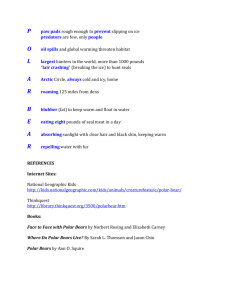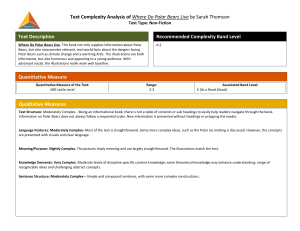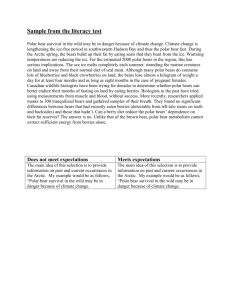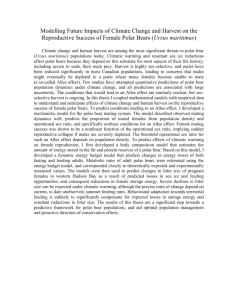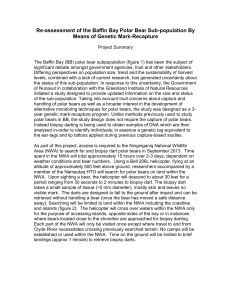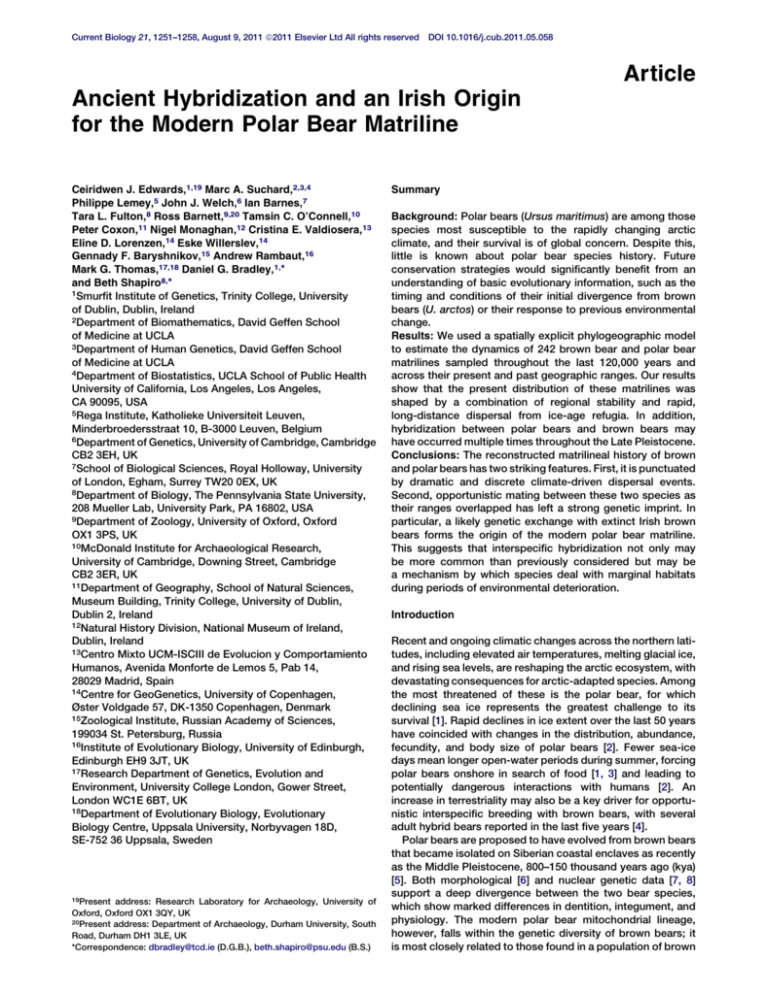
Current Biology 21, 1251–1258, August 9, 2011 ª2011 Elsevier Ltd All rights reserved
DOI 10.1016/j.cub.2011.05.058
Article
Ancient Hybridization and an Irish Origin
for the Modern Polar Bear Matriline
Ceiridwen J. Edwards,1,19 Marc A. Suchard,2,3,4
Philippe Lemey,5 John J. Welch,6 Ian Barnes,7
Tara L. Fulton,8 Ross Barnett,9,20 Tamsin C. O’Connell,10
Peter Coxon,11 Nigel Monaghan,12 Cristina E. Valdiosera,13
Eline D. Lorenzen,14 Eske Willerslev,14
Gennady F. Baryshnikov,15 Andrew Rambaut,16
Mark G. Thomas,17,18 Daniel G. Bradley,1,*
and Beth Shapiro8,*
1Smurfit Institute of Genetics, Trinity College, University
of Dublin, Dublin, Ireland
2Department of Biomathematics, David Geffen School
of Medicine at UCLA
3Department of Human Genetics, David Geffen School
of Medicine at UCLA
4Department of Biostatistics, UCLA School of Public Health
University of California, Los Angeles, Los Angeles,
CA 90095, USA
5Rega Institute, Katholieke Universiteit Leuven,
Minderbroedersstraat 10, B-3000 Leuven, Belgium
6Department of Genetics, University of Cambridge, Cambridge
CB2 3EH, UK
7School of Biological Sciences, Royal Holloway, University
of London, Egham, Surrey TW20 0EX, UK
8Department of Biology, The Pennsylvania State University,
208 Mueller Lab, University Park, PA 16802, USA
9Department of Zoology, University of Oxford, Oxford
OX1 3PS, UK
10McDonald Institute for Archaeological Research,
University of Cambridge, Downing Street, Cambridge
CB2 3ER, UK
11Department of Geography, School of Natural Sciences,
Museum Building, Trinity College, University of Dublin,
Dublin 2, Ireland
12Natural History Division, National Museum of Ireland,
Dublin, Ireland
13Centro Mixto UCM-ISCIII de Evolucion y Comportamiento
Humanos, Avenida Monforte de Lemos 5, Pab 14,
28029 Madrid, Spain
14Centre for GeoGenetics, University of Copenhagen,
Øster Voldgade 57, DK-1350 Copenhagen, Denmark
15Zoological Institute, Russian Academy of Sciences,
199034 St. Petersburg, Russia
16Institute of Evolutionary Biology, University of Edinburgh,
Edinburgh EH9 3JT, UK
17Research Department of Genetics, Evolution and
Environment, University College London, Gower Street,
London WC1E 6BT, UK
18Department of Evolutionary Biology, Evolutionary
Biology Centre, Uppsala University, Norbyvagen 18D,
SE-752 36 Uppsala, Sweden
19Present
address: Research Laboratory for Archaeology, University of
Oxford, Oxford OX1 3QY, UK
20Present address: Department of Archaeology, Durham University, South
Road, Durham DH1 3LE, UK
*Correspondence: dbradley@tcd.ie (D.G.B.), beth.shapiro@psu.edu (B.S.)
Summary
Background: Polar bears (Ursus maritimus) are among those
species most susceptible to the rapidly changing arctic
climate, and their survival is of global concern. Despite this,
little is known about polar bear species history. Future
conservation strategies would significantly benefit from an
understanding of basic evolutionary information, such as the
timing and conditions of their initial divergence from brown
bears (U. arctos) or their response to previous environmental
change.
Results: We used a spatially explicit phylogeographic model
to estimate the dynamics of 242 brown bear and polar bear
matrilines sampled throughout the last 120,000 years and
across their present and past geographic ranges. Our results
show that the present distribution of these matrilines was
shaped by a combination of regional stability and rapid,
long-distance dispersal from ice-age refugia. In addition,
hybridization between polar bears and brown bears may
have occurred multiple times throughout the Late Pleistocene.
Conclusions: The reconstructed matrilineal history of brown
and polar bears has two striking features. First, it is punctuated
by dramatic and discrete climate-driven dispersal events.
Second, opportunistic mating between these two species as
their ranges overlapped has left a strong genetic imprint. In
particular, a likely genetic exchange with extinct Irish brown
bears forms the origin of the modern polar bear matriline.
This suggests that interspecific hybridization not only may
be more common than previously considered but may be
a mechanism by which species deal with marginal habitats
during periods of environmental deterioration.
Introduction
Recent and ongoing climatic changes across the northern latitudes, including elevated air temperatures, melting glacial ice,
and rising sea levels, are reshaping the arctic ecosystem, with
devastating consequences for arctic-adapted species. Among
the most threatened of these is the polar bear, for which
declining sea ice represents the greatest challenge to its
survival [1]. Rapid declines in ice extent over the last 50 years
have coincided with changes in the distribution, abundance,
fecundity, and body size of polar bears [2]. Fewer sea-ice
days mean longer open-water periods during summer, forcing
polar bears onshore in search of food [1, 3] and leading to
potentially dangerous interactions with humans [2]. An
increase in terrestriality may also be a key driver for opportunistic interspecific breeding with brown bears, with several
adult hybrid bears reported in the last five years [4].
Polar bears are proposed to have evolved from brown bears
that became isolated on Siberian coastal enclaves as recently
as the Middle Pleistocene, 800–150 thousand years ago (kya)
[5]. Both morphological [6] and nuclear genetic data [7, 8]
support a deep divergence between the two bear species,
which show marked differences in dentition, integument, and
physiology. The modern polar bear mitochondrial lineage,
however, falls within the genetic diversity of brown bears; it
is most closely related to those found in a population of brown
Current Biology Vol 21 No 15
1252
Marine Isotope Stage
5a-d
4
3
2
1
Polar Bears
North Africa
Central Europe
Eastern Europe
Britain & Ireland
Southern Europe
Scandinavia
Asia
Siberia / W Beringia
Japan
Kamchatka
Alaska / E Beringia
Central N America
Clade II
N Am.
Asia
Europe/N Africa
5e
A
(ABC)
B
(Atlas)
Clade I
C
(Syrian)
Clades III & IV
(IIIa)
(IV)
120
100
80
60
40
20
0
Thousand Years BP
Figure 1. Maximum Clade Credibility Genealogy Describing the Estimated
Evolutionary History of Sampled Brown and Polar Bear Matrilines
Maximum clade credibility (MCC) genealogy resulting from a phylogeographic BEAST [39] analysis of 242 brown bears and polar bears ranging
in age from 120 thousand years ago (kya) to modern. Colors along the
branches describe the most probable geographic location of each lineage.
Black circles indicate major nodes with >85% posterior support, summarized from the combined output of three Markov chain Monte Carlo chains run
for 150 million iterations each and sampled every 10,000 iterations. Letters
A–C highlight nodes discussed in the main text. Background shades of
gray indicate warm (light gray) and cool (dark gray) marine isotope stages.
bears from the Admiralty, Baranof, and Chichagof (ABC)
islands of southeastern Alaska [9–13]. These data have been
used to support the hypothesis that the morphological differences between the two species may be due to rapid adaptation of polar bears to their highly specialized arctic lifestyle
[10, 14] and that the mitochondrial phylogeny reflects incomplete lineage sorting [14]. Alternatively, the sister relationship
between ABC island brown bears and polar bears may be
explained by recent hybridization between the two species
and the introgression of a brown bear mitochondrial lineage
into polar bears. Although both bears are strongly maternally
philopatric, the geographic distribution of their matrilines is
not stable through time [15], and lineage-wide extinctions
may be frequent [16].
We used a spatially explicit Bayesian inference approach
to examine different phylogeographic histories of brown
bear and polar bear matrilines sampled over at least the last
100 kya. We incorporated data from every geographic location
known to have been occupied by brown bears during the time
since the estimated most recent common ancestor (MRCA) of
modern polar bear matrilines (circa 45 kya; [10, 17]), including
a previously unsampled Late Pleistocene population of brown
bears from the vicinity of modern-day Britain and Ireland. We
also included two recently published ancient polar bear matrilines, both believed to come from bones older than 110 kya
[10, 14], and 51 mitochondrial sequences from modern and
Holocene (up to 8000 years old) polar bears, resulting in
a data set that spans the present geographic distributions of
both bear species.
Results and Discussion
Late Pleistocene/Holocene Phylogeography of Brown
and Polar Bears
The recent history of polar bear and brown bear matrilines was
characterized by long periods of geographic stability punctuated by episodes of rapid matrilineal dispersal, often over
considerable geographic distances (Figure 1; Figure 2; see
also Figure S1 available online). This is best illustrated by the
inferred radiation of brown bears out of Alaska during the
marine isotope stage (MIS) 3 interstadial (Bayes factor, BF [18],
support for Alaska in comparison to any other location = 45),
which was a period of peak environmental conditions for
ice-age megafauna [19]. This rapid, long-distance radiation
(clade IIIa, Figure 1) established clusters of closely related
matrilines in Japan, Kamchatka, Siberia, and both Eastern
and Central Europe by 14 kya.
Clade II was much more geographically widespread during
MIS 3 than it is today and comprised brown bears from Siberia,
Alaska, and modern-day Britain and Ireland, as well as the two
ancient polar bear matrilines (Figure 1). After the last glacial
maximum (LGM), clade II was isolated to small regions of
Alaska (ABC islands) and the vicinity of modern-day Ireland
(Figure 1). Modern brown bears living on the ABC islands share
a matrilineal common ancestor 37–10 kya (median 24 kya),
a timing coincident with climatic changes surrounding the
LGM that may have led to their isolation from brown bears
living on the mainland. In Ireland, brown bears carrying the
As noted previously [15, 16], the branching order among the earliest
diverging branches is not well resolved, with the exception of very high
support (99.97%) for monophyly of the clade III/IV lineage. See also Figure S1. Table S1 contains detailed information about the specimens used
in this analysis.
Ancient Hybridization of Brown and Polar Bears
1253
Alaska
Scandinavia
polar
bears
Ireland/
UK
Eastern Europe
Central
Europe
Southern
Europe
Asia
North
Africa
From
Southern Europe
Central Europe
Britain & Ireland
Alaska
Britain & Ireland
To
North Africa
Southern Europe
Polar Bear
Siberia
Alaska
Lower 48
United States
Japan
BF
280
180
140
120
51
From
Central Europe
Central Europe
Alaska
Siberia
Siberia
To
Britain & Ireland
Scandinavia
Japan
Eastern Europe
Japan
BF
25
15
11
9
9
From
Siberia
Scandinavia
Siberia
Kamchatka
To
Kamchatka
Britain & Ireland
Central Europe
Eastern Europe
BF
8
8
8
8
Figure 2. Reconstructed Spatial Diffusion Pathways of Brown and Polar Bear Matrilines over the Last 120,000 Years
Map indicating the 13 locations to which each matriline was assigned and the 14 significant diffusion pathways that describe the maternal phylogeographic
history of brown bears and polar bears over the last circa 120 kya. For the phylogeographic analyses, we assigned all polar bears to a single geographic
location, depicted here as Svalbard. Nonreversible diffusion rates are estimated across the entire distribution of posterior trees and therefore reflect average
rates of diffusion over time. Rates are considered to be significantly different from zero with Bayes factor (BF) > 8. The significant diffusion pathways are
shown in pink, with increasing significance indicated by darker shades and arrows indicating the direction of diffusion. An interactive visualization of the
diffusion process of the ancestral bear matrilines over time is available at http://www.phylogeography.org/BEARS.html. Figure S2 describes the results
of two sensitivity analyses performed to assess the phylogeographic results depicted here and in Figure 1.
clade II matriline are present prior to 26 kya and again after 12
kya, but no bear fossils of any kind have been dated to the LGM
(Table S2; Figure 3), suggesting that suitable habitat may not
have persisted in Ireland through the peak of the last ice age.
The Origin and Evolution of the Polar Bear Matriline
As has been shown previously, all modern polar bear matrilines cluster within clade II (Figure 1). However, in contrast to
previous analyses, we found no evidence for reciprocal monophyly between brown and polar bears within this clade, nor do
our results support a sister relationship of polar bears with the
ABC island brown bears. Instead, the inferred common matrilineal ancestor of modern polar bears falls within the genetic
diversity of Irish brown bears (BF = 53). The low posterior
support for modern polar bear monophyly (Figure 1, node A)
is due to modern polar bear lineages frequently clustering
into several clades within the diversity of clade II Irish brown
bears in the posterior distribution of trees.
The two older polar bear matrilines, one isolated from
a jawbone from Svalbard [10] associated with a stratigraphic
layer dated to 130–110 kya [20] and another from a rib bone
from northern Norway believed to date to circa 115 kya [14],
also fall within clade II (Figure 1, node B). However, although
these two sequences are closely related to each other, they
are not directly ancestral to the modern polar bear matriline:
modern polar bear matrilines cluster with the ancient polar
bear matrilines with less than 5% posterior probability. If
incomplete lineage sorting were to explain these results, as
suggested previously [14], the coalescent event of the two
lineages in question would have to have taken place prior to
speciation. Because the coalescence of all modern polar
bear matrilines postdates the age of the two ancient bears
(and therefore the speciation date), hybridization followed by
matrilineal introgression is much more likely than incomplete
lineage sorting to explain the observed data.
Figure 4 describes three hypothetical scenarios that may
explain the phylogeographic relationships presented here. In
the scenario depicted in Figure 4A, the timing of the initial
divergence between brown bear and polar bear matrilines is
the same as our estimated MRCA of modern polar bear matrilines. This scenario describes most closely the prevailing
hypothesis explaining the mitochondrial data: a sister relationship between polar bear matrilines and those of ABC island
brown bears. However, although it is consistent with conditions during the LGM favoring the emergence of a cold-adapted species, the timeline of this scenario conflicts with both the
existence of the two ancient polar bears and the high degree of
morphological and behavioral dissimilarity between brown
bears and polar bears. This hypothesis could only be tenable
if the ancient polar bear sequences contain errors that force
them to fall erroneously outside of the diversity of the modern
polar bears and the ancient Irish and ABC island brown bears.
The scenario depicted in Figure 4B accommodates the two
ancient polar bears by allowing brown bear and polar bear
matrilines to diverge earlier than depicted in Figure 4A. In this
scenario, the maternal MRCA of polar bears, Irish brown bears,
and ABC island brown bears diverged from ancestral brown
bears carrying the clade II matriline during the Pleistocene.
Because of uncertainty surrounding the age of the two ancient
polar bear fossils, we allow the age of both mitochondrial lineages to be random variables drawn from a distribution ranging
from the oldest bound on their stratigraphic dates (130 kya) to
the most recent bound on their radiocarbon dates (40 kya)
using a tip-sampling method [21]. The estimated age of the
MRCA of clade II matrilines is 135–111 kya, roughly similar to
but slightly younger than that estimated by either Lindqvist
et al. [10] (152 kya) or Davison et al. [14] (160 kya). This most
likely reflects differences between methods used to calibrate
the molecular clock, because the incorporation of an external
(fossil) calibration will result in a slower overall evolutionary
Current Biology Vol 21 No 15
1254
A
B Site
7
4
6
5
1
3 2
150 km
1 - Castlepook Cave, Cork
2 - Shandon Cave, Waterford
3 - Foley Cave, Cork
4 - Kesh Corran and Plunkett
Cave, Sligo
5 - Red Cellar Cave, Limerick
6 - Edenvale Cave, Clare
and Newhall Cave, Clare
7 - Poll nam Béar Cave, Leitrim
and Polldownin Cave, Sligo
Figure 3. Ages and Geographic Locations of the
Sampled Fossil British and Irish Brown Bears
#
Sample age*
(BP +/- error)
mtDNA
clade
1
1
1
2
2
3
3
37870 +/- 1270
33310 +/- 770
32648 +/- 245
32430 +/- 670
28390 +/- 177
26340 +/- 320
26340 +/- 320
I
I
I
II
II
II
II
12143 +/- 46
11920 +/- 85
11460 +/- 57
10650 +/- 100
10495 +/- 51
9946 +/- 53
8719 +/- 48
4520 +/- 37
4136 +/- 37
3517 +/- 31
2956 +/- 33
I
II
II
II
II
II
II
I
I
I
I
LGM
Britain
4
4
5
6
6
5
7
7
7
7
Locations of origin (A) and uncalibrated accelerator mass spectrometry radiocarbon ages and
mtDNA clade assignments (B) for British and Irish
bears included in study. The shaded area in (A)
indicates the traditional limit of the last glacial
maximum (LGM) in Ireland. However, recent
work suggests that the shaded area probably
represents a subsequent ice sheet readvance
occurring 20.9–14.7 kya [32] and that Ireland
was completely covered in ice from circa
27–23 kya [29, 31]. Details of the Irish bear
samples and ancient DNA sequencing are
provided in Table S2.
bones from across Alaska made by
Otto Geist in the late 1930s that is now
housed at the American Museum of
Natural History in New York. Because
the fossil was an ulna belonging to
a juvenile, it could only be identified
morphologically as Ursus. However,
unlike the Irish brown bears, the isotopic
signature of this Alaskan bear is decidedly marine [15], leading the authors of
*uncalibrated radiocarbon date
the original publication to conclude
that the specimen was incorrectly provenanced and likely came from the coast
of Alaska rather than from Fairbanks.
rate [14]. In our analyses, the age of this particular node is Even if the provenance of this specimen is wrong, its radiohighly influenced by the age of the ancient polar bears. When carbon age (19,360 6 140 uncalibrated radiocarbon years
the ages of the two ancient polar bear sequences are sampled before present; lab accession number OxA-10036) suggests
between 130–100 kya, rather than 130–40 kya, the estimated that polar bears with clade II matrilines were present in Alaska
age of the MRCA of this node is 166–120 kya, overlapping throughout the LGM, providing additional support for the
with both our estimates using the less constrained age and multiple-hybridization scenario depicted in Figure 4B and
making it possible that more than one Irish matriline was
the previous estimates.
If the Irish bears carrying clade II matrilines, or at least those captured by polar bears prior to the Holarctic fixation of the
Irish bears associated with radiocarbon ages postdating the modern matriline.
In Figure 4C, brown bear and polar bear matrilines diverged
LGM, were actually polar bears and not brown bears, then
fewer hybridization events would be required to explain the prior to the mitochondrial diversification within brown bears.
observed data (in Figure 4B, only the transfer of the polar This allows more time for the evolution of each species’
bear matriline to the ABC island brown bears would be distinctive phenotype and is consistent with hypotheses of
required). However, bone isotopic data indicates that all Irish at least a Middle Pleistocene origin for polar bears [5] but
bears had a terrestrial diet similar to that of late Pleistocene requires multiple hybridizations with brown bears to explain
brown bears from Alaska [15] and dissimilar to the markedly both the Svalbard polar bear matriline and the modern polar
marine diet of polar bears (Supplemental Experimental Proce- bear matriline. If this hypothesis is correct, autosomal markers
dures). The scenario depicted in Figure 4B therefore predicts should support a divergence between polar bears and brown
the following: an older polar bear matriline, represented in bears prior to the divergence of all extant brown bears. To
our analysis by the two ancient polar bears, became wide- test this, we analyzed 20 nuclear loci isolated from all eight
spread across the Arctic. These polar bears hybridized oppor- extant species within the Ursidae [7, 8, 22]. The small evolutunistically with small, coastal populations of brown bears, tionary distance between brown bears and polar bears
leading in at least two instances to fixation of the polar bear prohibits precise estimates of the brown/polar divergence;
matriline in brown bear populations (Ireland and the ABC however, the 95% highest posterior density interval of estiislands). More recently, additional hybridization occurred in mated coalescence dates spans the interval 2 Mya–400 kya.
Ireland, followed by fixation of the Irish brown bear matriline Although there are a number of reasons unrelated to hybridizain polar bears. This marks the MRCA of the modern polar tion why the mitochondrial MRCA would be more recent than
most autosomal common ancestor dates, such as a smaller
bear matriline.
A single bear from Fairbanks, Alaska whose mtDNA mitochondrial effective population size, this date range
sequence was isolated as part of a previous study [15] also predates by a considerable margin the estimated MRCA of
falls within the cluster of Irish brown bear and modern polar polar bear and brown bear matrilines.
Regardless of which scenario prevails, modern polar
bear matrilines. The fossil from which this sequence was isolated is part of a large, geographically extensive collection of bears across their Holarctic distribution all share a common
Ancient Hybridization of Brown and Polar Bears
1255
A
Figure 4. Three Hypothetical Scenarios Describing the Divergence between Brown Bear and
Polar Bear Matrilines
(A) Recent speciation.
(B) Medium speciation plus multiple hybridization
events.
(C) Ancient speciation plus more recent hybridization.
The branching order of the bear matrilines is
based on the MCC tree in Figure 1. Colored background shading indicates the hypothetical polar
bear (blue) and brown bear (yellow) autosomal
lineages.
B
C
matrilineal ancestor within the last 51–20 kya. If polar bears
were already widely distributed at this time, this suggests
a complete replacement of the previous mitochondrial lineage
within a remarkably short time frame. Such a recent coalescence is feasible given current estimates of their effective
population size (Ne): if the mitochondrial haplotypes were
selectively equivalent and assuming a female Ne of 2,025
based on an estimated 18% of females reproducing in a total
census size of 10,000–12,500 females and a female generation
time of 9.7 years [23], our sample of 51 modern mitochondrial
alleles would coalesce with 95% probability in 93.2–12.9 kya
(median 33.4 kya; Supplemental Experimental Procedures).
The timescale we present is derived from evolutionary rates
calibrated using dated ancient DNA sequences; previous
work has suggested that this may overestimate rates and
therefore underestimate time since divergence [24]. However,
recent evidence suggests that time dependency may not
significantly affect rate estimates over
relatively short time frames, such as
those spanned by our genealogies [25].
Crucially, our phylogeographic estimates of the timing of establishment
of four different brown bear mtDNA
lineages coincide with paleontological
evidence of the first bears in those locations, providing independent support
for the accuracy of the tip-calibrated
mtDNA evolutionary rates. Specifically,
this includes the establishment of the
clade III/IV lineage in Alaska (BF = 27)
105–70 kya [26], the first appearance
of clade IIIa in eastern Europe by
24–5 kya (median 12 kya) [27], the recolonization of Scandinavia by bears
28–9 kya (median 11 kya) [27, 28], and
the movement of bears carrying clade I
from Spain into North Africa 8.5–1.6
kya (median 3.2 kya) (Figure 1, node C,
which likely reflects translocation of
bears by the Romans or Carthaginians
for organized wild animal combat).
The Role of Hybridization in Polar
Bear Evolution
Hybridization between brown bears and
polar bears occurred during a period
of rapid climate change, when fluctuations in the amount and distribution
of habitat in the North Atlantic would
have provided ample opportunity for their ranges to overlap,
and therefore optimal conditions for opportunistic mating.
These same rapid changes may have led to population size
fluctuations, which in turn could contribute to the rapid fixation
of introgressing mitochondrial lineages. The British-Irish ice
sheet (BIIS) reached its maximum extent 22–20 kya, with major
tidewater glaciers on the western shelf and down the Irish
Sea basin into the Celtic Sea [29–31], providing an ideal habitat
for polar bears. Pockets of ice-free refugia comprising open,
treeless steppe tundra similar to that of Beringia may have
remained in southern Ireland during the LGM [32, 33], or at
least up until 26 kya, when our radiocarbon dates indicate
that bears were still present in Ireland, and again after the
initial deglaciation of the BIIS 24–23 kya [29, 34]. Because
most of Ireland would have been uninhabitable even during
the period leading up to the LGM (Figure 3), brown bears
may have been forced to use transient, suitable habitat such
Current Biology Vol 21 No 15
1256
as sea ice shelves, nunataks, or land exposed by lower sea
levels, increasing the potential for contact with polar bears.
The modern distribution of bear matrilines likely arose as
a consequence of long-term local stability punctuated by
rapid, climate-driven dispersals and opportunistic mating
between polar bears and brown bears. Today, the arctic
climate is again changing rapidly, and the habitat of brown
and polar bears is once again beginning to overlap, providing
the opportunity for the two species to hybridize. Although the
evolutionary role of hybridization is not yet completely understood, the recent proliferation of molecular genetic data is
revealing a growing number of examples from both plants
and animals [35]. Hybridization is known to occur more
frequently in regions where population density is low, or where
species are near the edge of their ecological range [36], and in
some circumstances may provide the means to replace
damaged alleles or to transfer novel traits between species,
providing a fitness advantage to hybrid offspring [35].
Whereas vulnerable populations of both bear species are
currently protected, the protection status of hybrids is less
clear, with a 1996 proposed US policy to protect hybrids [37]
yet to be finalized. Although the extent of any fitness differential between hybrid brown/polar bears and their parents
remains unclear, given the increasing evidence of hybridization among many threatened arctic taxa [4], it may be appropriate to reconsider protection of hybrids, because they may
play an underappreciated role in the survival of species. Our
results suggest that, although the genetic mixing observed in
bears today may be an important component of the longterm evolution of the polar bear, brown and polar bears have
remained evolutionarily distinct lineages over geological
time, suggesting that they are likely to remain as such in the
future.
Experimental Procedures
Data Collection
We extracted DNA from 23 ancient Irish bears, 30 historic polar bears, four
early Holocene (circa 8 kya) polar bears, and 17 modern polar bears (Table
S1; Table S2). Fragments of the mtDNA hypervariable region (HVR) were
selected and amplified so as to overlap with previously published ancient
and modern matrilines (Supplemental Experimental Procedures). Matrilineal
clade assignments for ancient Irish bears were verified by amplifying an
additional fragment from the mitochondrial cytochrome b (cytb) gene.
Protocols to control for contamination and validate ancient results were
followed at each step. Mitochondrial sequence data have been deposited
at GenBank with the accession numbers JF900098–JF900175. Additional
HVR sequences were collected from GenBank to compile a data set of
242 brown and polar bear matrilines representing their entire geographic
distribution over the last 120,000 years. Twenty nuclear loci were also
collected from GenBank for each of the eight extant species of Ursidae.
Model Development
We extended a recent approach to infer the spatial dynamics of measurably
evolving populations [38] that now allows for different rates of diffusion
between locations depending on the direction traveled, thereby providing
a more realistic approximation of the geographic diffusion process of large
mammals through time. Our novel approach employs a continuous-time
Markov chain (CTMC) model in which diffusion between n locations is characterized by an n 3 n rate matrix, L, that contains n(n 2 1) off-diagonal,
nonnegative rate parameters lij for i, j = 1,.,n. Previously, phylogenetic
modeling (e.g., [38]) assumed that lij = lji, or at least that L is similar to
a symmetric matrix, as in, for example, the HKY and GTR models.
For our general case, it is possible to decompose L = V D V21, where
matrix V is a set of real eigenvectors and matrix D is of block diagonal
form with 1 3 1 submatrices of real eigenvalues and 2 3 2 submatrices of
complex conjugate pairs of eigenvalues. To draw inference under this
extended model, we devised new algorithms to compute the likelihood of
the observed locations at the tips of the tree by determining the CTMC
finite-time transition probabilities exp(Lt) for real times t along each branch.
Because the amount of phylogeographic data is small, we adopted
a Bayesian stochastic search variable selection (BSSVS) procedure to
select among all possible migration pathway scenarios [38]. We provide
details of this model and its implementation in BEAST [39] with BEAGLE
[40] (Supplemental Experimental Procedures).
Phylogenetic Analyses
For the phylogeographic analyses, we ran two independent Markov chain
Monte Carlo (MCMC) simulations of 50 million iterations using the model
described above for two different data sets: (1) using just the HVR and (2)
incorporating complete mtDNA genomes for ten bears. We assumed the
HKY+G model of nucleotide substitution and either the flexible Bayesian
skyride [41] or Bayesian skyline [42] coalescent priors [41] (Supplemental
Experimental Procedures). Mean accelerator mass spectrometry radiocarbon dates for ancient specimens calibrated the molecular clock. Six
ancient specimens originating from underrepresented geographic regions
were included: one from Siberia [15], three from Valdegoba Cave, Spain
[43], and two ancient polar bears from Norway [10, 14]. For each of these,
the age of the sequences was assumed a priori to arise from a lognormal
distribution reflecting the most likely age range of that specimen. Tip ages
were numerically integrated via sampling in the MCMC chain for each of
these six specimens simultaneously with evolutionary and demographic
parameters [21]. Initially, we performed analyses with and without the postmortem damage (PMD) model [44] to assess the influence of potentially
damaged nucleotides sites on the phylogenetic analysis. A BF comparison
[18] indicated that the PMD model did not improve the model fit, and we
excluded the PMD model from further analyses.
In all MCMC simulations, we subsampled the posterior realizations every
10,000 iterations to decrease autocorrelation and discarded the first 10% as
chain burn-in. For a given data set, we combined remaining samples from all
chains to draw inference. Effective sample size estimates and parameter
trace plots supported MCMC convergence. We computed the summary
maximum clade credibility (MCC) tree (Figure 1) using TreeAnnotator and
developed a BF test [18] to identify which diffusion links were statistically
significant (BF > 8; Figure 2).
We performed two different sensitivity analyses that are described in
detail in Supplemental Experimental Procedures. First, to investigate the
impact of unsampled populations on the Irish-polar bear phylogeographic
link, we simulated unknown (cryptic) lineages in clade II and measured relevant BF support for the conclusion of Irish ancestry of modern polar bear
sequences (Figure S2A). Second, we explored the effect of sampling heterogeneity on root state probabilities using location state randomization
(Figure S2B).
To provide a spatial projection, we converted the MCC tree, inferred
posterior modal node locations, and median node heights into a keyhole
markup language (KML) file. The resulting interactive visualization is available from http://www.phylogeography.org/BEARS.html.
To compare nuclear and mitochondrial species topologies and to further
test the hypothesis that polar bear matrilines are recently derived from
a subset of those in brown bears, we performed additional analyses using
up to 20 nuclear loci (Supplemental Experimental Procedures). For these
analyses, we assumed a Yule prior to inform the speciation rate. We
assumed both strict and relaxed clocks and calibrated the phylogenies by
drawing the age of the radiation of the Ursinae from a lognormal distribution
with 95% of the probability density between 5 and 3 Mya [45].
Accession Numbers
New brown and polar bear mitochondrial sequence data have been deposited at GenBank with the accession numbers JF900098–JF900175.
Supplemental Information
Supplemental Information includes two figures, two tables, Supplemental
Experimental Procedures, and Supplemental Acknowledgments and can
be found with this article online at doi:10.1016/j.cub.2011.05.058.
Acknowledgments
We thank E. Regehr, T. Evans, the US Fish and Wildlife Service, and the
Marine Mammals Tissue Bank for providing modern polar bear samples
for analysis and G. Zazula for providing ancient samples. C.J.E. was
Ancient Hybridization of Brown and Polar Bears
1257
supported by the Irish Research Council for Science Engineering and Technology (SC/2002/510 and 04/BR/B0390). M.A.S. is partially supported by
National Institutes of Health (NIH) grant R01 GM086887 and a John Simon
Guggenheim Memorial Fellowship. P.L. is supported by the Fund for Scientific Research (FWO) Flanders. B.S. and T.L.F. are supported by NIH R01
GM083603-01 and National Science Foundation (NSF) ARC-0909456. The
research leading to these results received funding from the European
Research Council under the Seventh Framework Programme (FP7/20072013)/ERC grant agreement number 260864. Collaboration between B.S.,
M.A.S., A.R., and P.L. was supported by the National Evolutionary Synthesis
Center (NESCent) grant NSF EF-0423641.
Received: March 18, 2011
Revised: May 19, 2011
Accepted: May 26, 2011
Published online: July 7, 2011
References
1. Amstrup, S.C., Marcot, B.G., and Davis, D.C. (2007). Forecasting the
Range-wide Status of Polar Bears at Selected Times in the 21st
Century (Reston, VA: US Geological Survey Administrative Report).
2. Derocher, A.E., Lunn, N.J., and Stirling, I. (2004). Polar bears in a warming climate. Integr. Comp. Biol. 44, 163–176.
3. Stirling, I., Richardson, E., Thiemann, G.W., and Derocher, A.E. (2008).
Unusual predation attempts of polar bears on ringed seals in the
southern Beaufort Sea: Possible significance of changing spring ice
conditions. Arctic 61, 14–22.
4. Kelly, B.P., Whiteley, A., and Tallmon, D. (2010). The Arctic melting pot.
Nature 468, 891.
5. Kurtén, B. (1964). The evolution of the polar bear, Ursus maritimus
(Phipps). Acta Zool. Fenn. 108, 1–30.
6. Slater, G.J., Figueirido, B., Louis, L., Yang, P., and Van Valkenburgh, B.
(2010). Biomechanical consequences of rapid evolution in the polar bear
lineage. PLoS ONE 5, e13870.
7. Pagès, M., Calvignac, S., Klein, C., Paris, M., Hughes, S., and Hänni, C.
(2008). Combined analysis of fourteen nuclear genes refines the Ursidae
phylogeny. Mol. Phylogenet. Evol. 47, 73–83.
8. Yu, L., Li, Q.W., Ryder, O.A., and Zhang, Y.P. (2004). Phylogeny of the
bears (Ursidae) based on nuclear and mitochondrial genes. Mol.
Phylogenet. Evol. 32, 480–494.
9. Cronin, M.A., Amstrup, K.S., Garner, G.W., and Vyse, E.R. (1991).
Interspecific and intraspecific mitochondrial DNA variation in North
American bears (Ursus). Can. J. Zool. 69, 2985–2992.
10. Lindqvist, C., Schuster, S.C., Sun, Y., Talbot, S.L., Qi, J., Ratan, A.,
Tomsho, L.P., Kasson, L., Zeyl, E., Aars, J., et al. (2010). Complete mitochondrial genome of a Pleistocene jawbone unveils the origin of polar
bear. Proc. Natl. Acad. Sci. USA 107, 5053–5057.
11. Shields, G.F., Adams, D., Garner, G., Labelle, M., Pietsch, J., Ramsay,
M., Schwartz, C., Titus, K., and Williamson, S. (2000). Phylogeography
of mitochondrial DNA variation in brown bears and polar bears. Mol.
Phylogenet. Evol. 15, 319–326.
12. Shields, G.F., and Kocher, T.D. (1991). Phylogenetic relationships of
North American ursids based on analysis of mitochondrial DNA.
Evolution 45, 218–221.
13. Talbot, S.L., and Shields, G.F. (1996). Phylogeography of brown bears
(Ursus arctos) of Alaska and paraphyly within the Ursidae. Mol.
Phylogenet. Evol. 5, 477–494.
14. Davison, J., Ho, S.Y.W., Bray, S., Korsten, M., Vulla, E., Hindrikson, M.,
Østbye, K., Østbye, E., Lauritzen, S.-E., Austin, J., et al. (2011). LateQuaternary biogeographic scenarios for a wild mammal model species,
the brown bear (Ursus arctos). Quat. Sci. Rev. 30, 418–430.
15. Barnes, I., Matheus, P., Shapiro, B., Jensen, D., and Cooper, A. (2002).
Dynamics of Pleistocene population extinctions in Beringian brown
bears. Science 295, 2267–2270.
16. Calvignac, S., Hughes, S., Tougard, C., Michaux, J., Thevenot, M.,
Philippe, M., Hamdine, W., and Hänni, C. (2008). Ancient DNA evidence
for the loss of a highly divergent brown bear clade during historical
times. Mol. Ecol. 17, 1962–1970.
17. Ho, S.Y., Saarma, U., Barnett, R., Haile, J., and Shapiro, B. (2008). The
effect of inappropriate calibration: Three case studies in molecular
ecology. PLoS ONE 3, e1615.
18. Suchard, M.A., Weiss, R.E., and Sinsheimer, J.S. (2001). Bayesian selection of continuous-time Markov chain evolutionary models. Mol. Biol.
Evol. 18, 1001–1013.
19. Zazula, G.D., Froese, D.G., Schweger, C.E., Mathewes, R.W., Beaudoin,
A.B., Telka, A.M., Harington, C.R., and Westgate, J.A. (2003).
Palaeobotany: Ice-age steppe vegetation in east Beringia. Nature 423, 603.
20. Ingólfsson, Ó., and Wiig, Ø. (2009). Late Pleistocene fossil find in
Svalbard: The oldest remains of a polar bear (Ursus maritimus Phipps,
1744) ever discovered. Polar Res. 28, 455–462.
21. Shapiro, B., Ho, S.Y., Drummond, A.J., Suchard, M.A., Pybus, O.G., and
Rambaut, A. (2011). A Bayesian phylogenetic method to estimate
unknown sequence ages. Mol. Biol. Evol. 28, 879–887.
22. Nakagome, S., Pecon-Slattery, J., and Masuda, R. (2008). Unequal rates
of Y chromosome gene divergence during speciation of the family
Ursidae. Mol. Biol. Evol. 25, 1344–1356.
23. Cronin, M.A., Amstrup, S.C., Talbot, S.L., Sage, G.K., and Amstrup, K.S.
(2009). Genetic variation, relatedness, and effective population size of
polar bears (Ursus maritimus) in the southern Beaufort Sea, Alaska.
J. Hered. 100, 681–690.
24. Ho, S.Y., Kolokotronis, S.O., and Allaby, R.G. (2007). Elevated substitution rates estimated from ancient DNA sequences. Biol. Lett. 3, 702–705.
25. Burridge, C.P., Craw, D., Fletcher, D., and Waters, J.M. (2008).
Geological dates and molecular rates: Fish DNA sheds light on time
dependency. Mol. Biol. Evol. 25, 624–633.
26. Kurtén, B., and Anderson, E. (1980). Pleistocene Mammals of North
America (New York: Columbia University Press).
27. Sommer, R., and Benecke, N. (2005). The recolonisation of Europe by
brown bears Ursus arctos Linnaeus 1758 after the last glacial maximum.
Mammal Rev. 35, 156–164.
28. Rinterknecht, V.R., Clark, P.U., Raisbeck, G.M., Yiou, F., Bitinas, A.,
Brook, E.J., Marks, L., Zelcs, V., Lunkka, J.P., Pavlovskaya, I.E., et al.
(2006). The last deglaciation of the southeastern sector of the
Scandinavian ice sheet. Science 311, 1449–1452.
29. Clark, C.D., Hughes, A.L.C., Greenwood, S.L., Jordan, C., and Sejrup,
H.P. (2010). Pattern and timing of retreat of the last British-Irish Ice
Sheet. Quat. Sci. Rev., in press. Published online October 28, 2010.
10.1016/j.quascirev.2010.07.019.
30. Coxon, P., and MacCarron, S.G. (2009). The Geology of Ireland, Second
Edition, H. Holland and I.A. Sanders, eds. (Dunedin, UK: Dunedin
Academic Press), pp. 355–396.
31. O’Cofaigh, C., Telfer, M.W., Bailey, R.M., and Evans, D.J.A. (2010). Late
Pleistocene chronostratigraphy and ice sheet limits, southern Ireland.
Quat. Sci. Rev., in press. Published online April 8, 2010. 10.1016/j.quascirev.2010.01.011.
32. Clark, C.D., Gibbard, P.L., and Rose, J. (2004). Pleistocene glacial limits
in England, Scotland and Wales. In Quaternary Glaciations: Extent
and Chronology, Part 1: Europe, J. Ehlers and P.L. Gibbard, eds.
(Amsterdam: Elsevier), pp. 47–82.
33. Stewart, J.R., Lister, A.M., Barnes, I., and Dalén, L. (2010). Refugia revisited: Individualistic responses of species in space and time. Proc. Biol.
Sci. 277, 661–671.
34. Chiverrell, R.C., and Thomas, G.S.P. (2010). Extent and timing of the last
glacial maximum (LGM) in Britain and Ireland: A review. J. Quat. Sci 25,
535–549.
35. Rieseberg, L.H. (2009). Evolution: Replacing genes and traits through
hybridization. Curr. Biol. 19, R119–R122.
36. Arnold, M.L. (1997). Natural Hybridization and Evolution (Oxford: Oxford
University Press).
37. United States Fish and Wildlife Service and National Oceanic and
Atmospheric Administration (1996). Endangered and threatened wildlife
and plants; Proposed policy and proposed rule on the treatment of
intercrosses and intercross progeny (‘‘hybridization’’). Fed. Regist. 61,
4710–4713.
38. Lemey, P., Rambaut, A., Drummond, A.J., and Suchard, M.A. (2009).
Bayesian phylogeography finds its roots. PLoS Comput. Biol. 5,
e1000520.
39. Drummond, A.J., and Rambaut, A. (2007). BEAST: Bayesian evolutionary analysis by sampling trees. BMC Evol. Biol. 7, 214.
40. Suchard, M.A., and Rambaut, A. (2009). Many-core algorithms for statistical phylogenetics. Bioinformatics 25, 1370–1376.
41. Minin, V.N., Bloomquist, E.W., and Suchard, M.A. (2008). Smooth
skyride through a rough skyline: Bayesian coalescent-based inference
of population dynamics. Mol. Biol. Evol. 25, 1459–1471.
Current Biology Vol 21 No 15
1258
42. Drummond, A.J., Rambaut, A., Shapiro, B., and Pybus, O.G. (2005).
Bayesian coalescent inference of past population dynamics from
molecular sequences. Mol. Biol. Evol. 22, 1185–1192.
43. Valdiosera, C.E., Garcı́a, N., Anderung, C., Dalén, L., Crégut-Bonnoure,
E., Kahlke, R.D., Stiller, M., Brandström, M., Thomas, M.G., Arsuaga,
J.L., et al. (2007). Staying out in the cold: Glacial refugia and mitochondrial DNA phylogeography in ancient European brown bears. Mol. Ecol.
16, 5140–5148.
44. Rambaut, A., Ho, S.Y., Drummond, A.J., and Shapiro, B. (2009).
Accommodating the effect of ancient DNA damage on inferences of
demographic histories. Mol. Biol. Evol. 26, 245–248.
45. Wayne, R.K., Van Valkenburgh, B., and O’Brien, S.J. (1991). Molecular
distance and divergence time in carnivores and primates. Mol. Biol.
Evol. 8, 297–319.

